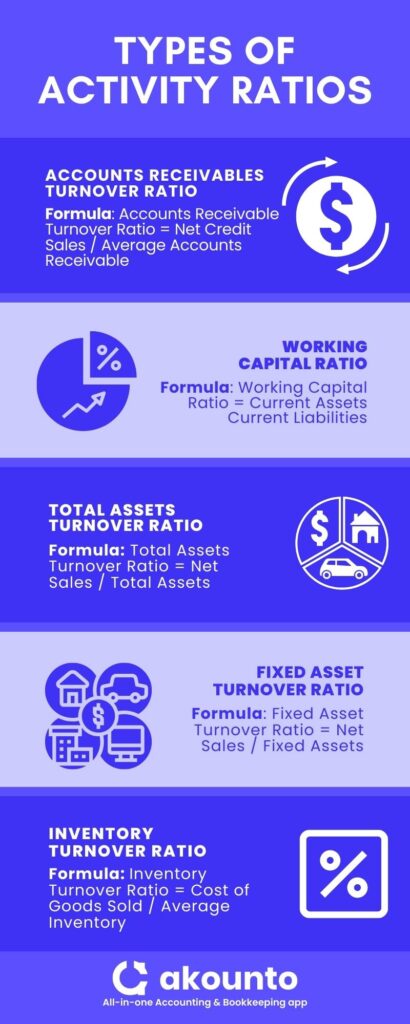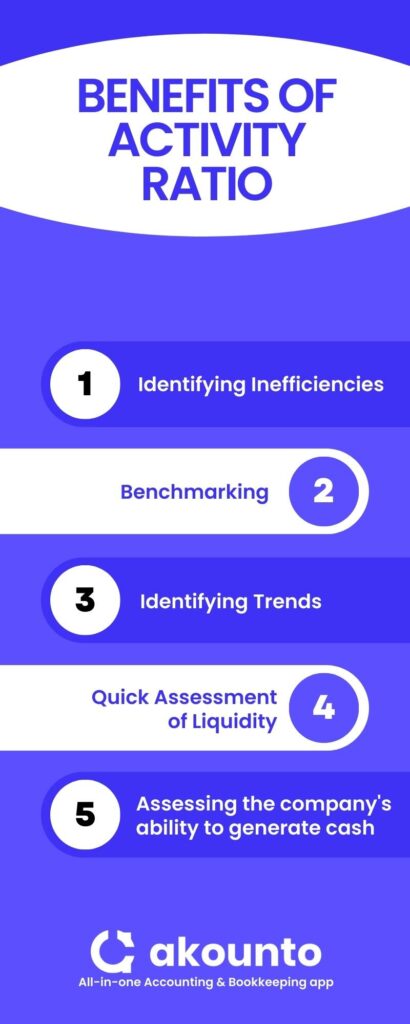An activity ratio measures a company’s ability to convert assets to generate revenue and cash.
Asset utilization ratios, also known as activity ratios, are indicators of a company’s operational efficiency in utilizing its total assets and liquidity position.
What Is An Activity Ratio?
An activity ratio is a financial metric that measures a company’s efficiency in leveraging assets, accounts receivables, and inventories on its balance sheet and generating revenue from them.
The activity ratio is the rate at which assets such as machinery and raw materials generate sales and profits.
Activity ratio formula is calculated by dividing one financial metric by another and is used to assess a company’s liquidity, solvency, and profitability. They are also known as efficiency ratios, performance ratios, or turnover ratios.
The different activity ratios, like working capital ratio, asset turnover ratio, etc., demonstrate how a company manages the different elements on the balance sheet and generates revenue.
What Is The Activity Ratio In Lean?
Activity ratios in lean are used to measure a company’s efficiency and production processes. These activity ratios measure metrics such as the number of units produced per hour, the number of defective units, and the amount of time spent on non-value-adding activities in the same sector.
By measuring these ratios, industry competitors can identify areas of inefficiency and take steps to improve their production processes.
How To Calculate Activity Ratio?
Activity ratios are called turnover ratios because the efficiency of converting an asset, like inventory, goods, fixed assets, etc., into cash is measured by it. It measures how quickly an asset cycle is churned during a business period.
One can calculate the accounts receivable turnover ratio by dividing average accounts receivable by net credit sales.
Other activity ratios may be calculated differently, but the basic formula is always the same: one financial metric divided by another.
What Are The Different Types Of Activity Ratios?

There are several activity ratios, each of which measures a different aspect of a company’s performance. Some common types of activity ratios include:
Accounts Receivables Turnover Ratio
The accounts receivables turnover ratio measures a company’s ability to collect its accounts receivable on time. A person can calculate it by dividing net credit sales by the average accounts receivable.
The accounts receivable ratio evaluates a company’s proficiency in converting its credit sales into cash and managing its accounts receivable.
Formula: Accounts Receivable Turnover Ratio = Net Credit Sales / Average Accounts Receivable
Example: If a company had net credit sales of $1,000,000 and average accounts receivable of $200,000, the accounts receivable turnover ratio would be 5.
Working Capital Ratio
The working capital ratio measures a company’s ability to manage its short-term assets and liabilities. One can calculate it by dividing current assets by current liabilities. A healthy working capital ratio should ideally be in the range of 1.2 to 2.0.
Formula: Working Capital Ratio = Current Assets / Current Liabilities
Example: Suppose a company had assets of $500,000 and liabilities of $300,000; the working capital ratio would be 1.67.
Total Assets Turnover Ratio
The total assets turnover ratio allows a company to measure its efficiency in using its assets to generate sales. They can calculate it by dividing net sales by total assets. A healthy assets turnover ratio differs in every sector; no ideal figure applies to all businesses.
Formula: Total Assets Turnover Ratio = Net Sales / Total Assets
Example: Let’s suppose a company had net sales of $2,000,000 and total assets of $1,500,000; the total assets turnover ratio would be 1.33
Fixed Asset Turnover Ratio
It measures the efficiency of a company by using its fixed assets to generate revenue. And one can calculate it by dividing net sales by fixed assets.
Formula: Fixed Asset Turnover Ratio = Net Sales / Fixed Assets
Example: Let’s suppose a company had net sales of $1,500,000 and fixed assets of $800,000; the fixed assets turnover ratio would be 1.88.
Inventory Turnover Ratio
The inventory turnover ratio measures a company’s operating efficiency in managing its inventory.
Formula: It is calculated by dividing the cost of goods sold by the company’s average inventory.
A slow-moving inventory, indicated by a low inventory turnover ratio, can indicate that capital is being tied up.
Conversely, a high inventory turnover ratio can mean that inventory is being sold quickly. So if the ratio is too high, it may result in stock-outs and missed sales opportunities.
Formula: Inventory Turnover Ratio = Cost of Goods Sold / Average Inventory
Example: If a company had a cost of goods sold of $1,200,000 and an average inventory of $200,000, the turnover ratio would be 6.
Benefits Of Activity Ratio

Activity ratios can provide several benefits to a company. For example, they can help a company identify areas of inefficiency.
- Identifying inefficiencies: Activity ratios can reveal areas where a company may be inefficient in managing its resources, such as a high inventory turnover ratio or low accounts receivable turnover.
- Benchmarking: Activity ratios can compare a company’s performance to industry averages or competitors.
- Identifying trends: By tracking activity ratios over time, a company can identify trends in its financial performance and adjust accordingly.
- A quick assessment of liquidity: Ratios such as the current and quick ratios give an idea of a company meeting its short-term obligations.
- Assessing the company’s ability to generate cash: Ratios such as the cash conversion cycle show how well the company converts its net annual sales into cash.
Activity Ratios Vs. Profitability Ratios
- Activity and profitability ratios measure different aspects of a company’s performance; both are necessary to understand a company’s financial health comprehensively. Activity ratios focus on a company’s average fixed assets efficiency and effectiveness in managing its resources, while profitability ratios focus on its ability to generate profits.
- For example, the asset turnover ratio is an activity ratio that measures a company’s efficiency in using its assets to generate sales. In contrast, the profitability ratio that measures a company’s ability to generate revenue is called a gross profit margin.
Conclusion
Activity ratios are an important tool for evaluating a company’s performance. They provide a clear picture of a company’s gross fixed assets and help determine the payables turnover ratio and fixed assets turnover.
By identifying areas of inefficiency, companies can take steps to improve their low inventory turnover ratio.
The Akounto blog is a great resource for anyone seeking help with accounting-related concepts or services for their business. Visit the website to sign up to explore expert services like bookkeeping, invoicing, tax filing, etc.




